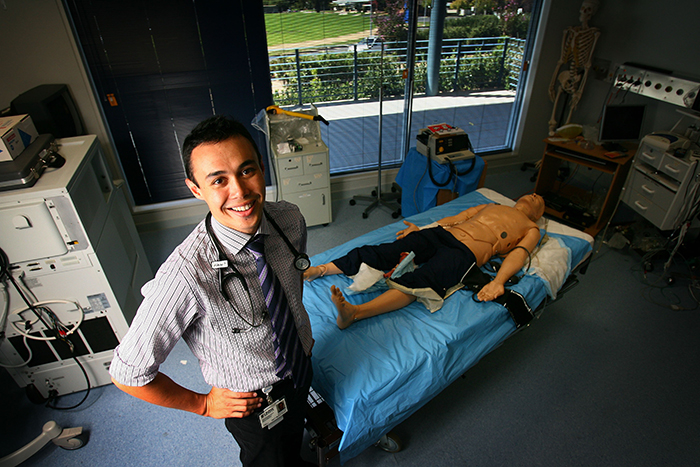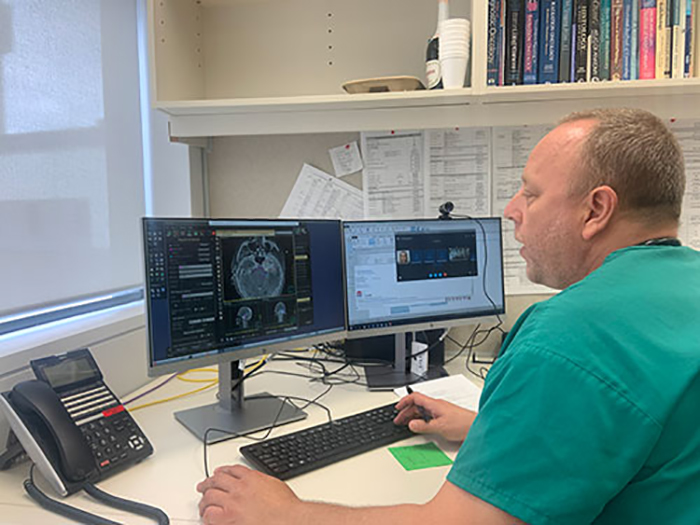 NSW Health
Search
NSW Health
Search
- Accelerating virtual care and telehealth
Accelerating virtual care and telehealth

In response to COVID-19, eHealth NSW has established a new multi-agency business unit called the Virtual Care Accelerator, in partnership with the Agency for Clinical Innovation (ACI) and other key stakeholders such as local health districts, specialty health networks, the Ministry of Health, the Clinical Excellence Commission (CEC), HealthShare NSW and other pillars.
‘The Accelerator is all about taking the COVID-related demand for virtual care and future-proofing it so that patients see long-term benefits from the investments currently being made,’ said Dr Shannon Nott, Clinical Director of the Virtual Care Accelerator.
Throughout the pandemic virtual care and telehealth have allowed people to access essential health services in their home and supported self-isolation and quarantine policies to reduce risk of COVID-19 spread in the community. They have also limited unnecessary exposure of patients and health professionals wherever treatment can be safely delivered by phone or videoconferencing.
Use of videoconferencing for clinical and general communication purposes has significantly increased during the COVID-19 pandemic. This was driven by a shift to working from home but also by the Federal Government’s announcement of expansion of telehealth item numbers through Medicare.
Virtually-enabled healthcare continues to be on the rise with NSW Health recording an increased uptake of virtual meetings by 641 per cent and peer-to-peer calls by 1,060 per cent between February and April 2020, compared to the same period last year.
myVirtualCare
Throughout the pandemic Virtual Care and Telehealth have allowed people to access essential health services in their home and supported self-isolation and quarantine policies to reduce risk of COVID-19 spread in the community. They have also limited unnecessary exposure of patients and health professionals wherever treatment can be safely delivered by phone or videoconferencing.
Last month, NSW Health introduced and is now scaling up, the use of a new Telehealth modality called myVirtualCare. For clinicians, myVirtualCare allows them to schedule, assess and manage their patients through a technology platform custom-built to streamline out-of-hospital or in-home care via any internet-enabled device in the community.

For patients, myVirtualCare provides an experience which allows them to access their clinician wherever most convenient. myVirtualCare closely mimics the physical experience of seeing a doctor in a clinic environment – but instead of a real waiting room, they arrive in a virtual one and are invited into a meeting room by their clinician.
NSW Health is also currently working towards improving and expanding the use of over-the-bed cameras in our hospitals. These cameras enable patients to receive a virtual critical care consultation from the right clinician at the right time, even if that clinician is not physically present at the hospital.
Approximately 500 new
neo-natal and critical care cameras will be installed at health organisations across NSW within the next 12 months. They will be rolled out in phases, with urgent installation happening at Sydney, Mid North Coast, Southern NSW and Northern NSW local health districts.
The Virtual Care Accelerator
The Virtual Care Accelerator is responsible for taking the lessons learned during NSW Health’s Virtual Care journey to date and through our COVID-19 response to ensure patients can continue to benefit from innovative, virtually-enabled models of care that address key health challenges across NSW.
‘Virtual Care is fast becoming business-as-usual for NSW Health,’ said Dr Shannon Nott, Clinical Director of the Virtual Care Accelerator.
‘The accelerator is all about taking the COVID-related demand for virtual care and future-proofing it so that patients see long-term benefits from the investments currently being made.”
eHealth NSW and key partners will spend the next 12 months focusing on embedding system-wide, high-value models of virtual care. These models will be supported by advances in technology to personalise patients’ healthcare, improve health outcomes and promote clinical collaboration across Australia’s largest public health system.
Dr Nott said, ‘NSW Health has a strong track record of innovating in the virtual care space, with many local health districts having run successful programs for well over a decade.’

‘Organisations such as Sydney, Western Sydney and South Eastern Sydney local health districts have proven that advances in technology can support managing the COVID-positive patient in home through remote monitoring platforms that are safe and add value to face-to-face care.
‘Rural facilities have long utilised Telehealth to improve access to healthcare for their patients. Western NSW LHD’s vCare unit and Virtual Rural Generalist Service as well as Murrumbidgee’s Patient Flow and Transport Unit show the strength of virtual care in assisting clinicians at the coalface with wrap-around acute care and critical care support. And Sydney LHD’s ‘RPA Virtual’ has demonstrated the effectiveness of similar approaches within a large metropolitan health service.
‘These are but a few of the hundreds of innovative projects across our LHDs supporting patient care.
‘What COVID-19 has done has proven beyond a doubt the value of virtual care,’ Dr Nott said.
‘We want to build on this foundation to ensure it continues to improve outcomes for patients and families. We want to enable our system to utilise advances in technology which will support our clinicians to develop models of care that support the challenges we face as a health system. It’s all about ensuring we truly place patients at the centre of care.’
Expanding virtual care models beyond the acute space and into community settings is another focus.
‘Doing this will bolster primary care capacity across NSW and enable us to work across the system to better collaborate for the benefit of our patients,’ said Dr Nott, adding consumer representatives will play an important part developing and driving models of care.
Importantly, these virtual care models and technology have huge potential to bolster hospitals’ capacity through enabling remote monitoring to take place in community and home settings.
Medicare-subsidised telehealth
The Australian Government increased the Medicare-subsidised telehealth services for a period of six months from 1 April to 30 September 2020 providing extra incentives for general practitioners and other health practitioners to use the technology to provide continued access to essential primary health services throughout the pandemic.
Virtual Care and Telehealth services can be used to assist patients with a range of medical conditions. You can find out more about COVID-19 Temporary MBS Telehealth Items by visiting the
Department of Health.
Page Updated: Thursday 16 July 2020
Contact page owner:
Health Protection NSW
 (20min delay)
(20min delay)









